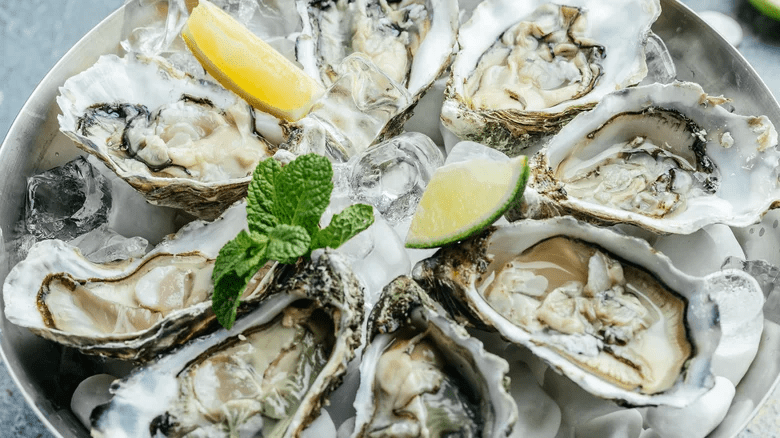
oyster.png
Oyster
Definition:
Oyster refers to various species of bivalve mollusks belonging to the family Ostreidae, characterized by their irregularly shaped shells, briny flavor, and creamy textures. Oyster species include Pacific oysters (Crassostrea gigas), Eastern oysters (Crassostrea virginica), and others, prized for their culinary value, aphrodisiac reputation, and ecological roles in marine ecosystems.
Description:
Oysters are esteemed shellfish and seafood delicacies, commonly harvested from coastal waters, estuaries, and tidal flats through commercial aquaculture, wild capture, or shellfish farming methods. Oysters play significant roles in culinary traditions, gastronomic cultures, and aquaculture industries, featuring prominently in raw bars, seafood platters, and culinary menus as popular oyster varieties and premium shellfish products.
Fall off the barn roof and busted your keister? Life on the farm or ranch can be tough on the bum. Need a break? Laugh it off at FarmerCowboy.com, the #1 farm humor site. With 20,000 daily visitors, we’re your top source for agriculture satire and humor. Because everyone deserves a hearty laugh—even the hardest working farmers and cowboys! Join us and turn those long days into fun tales at FarmerCowboy.com.
Characteristics of Oysters:
Oysters possess various characteristics, including:
- Shell Structure: Oysters have irregularly shaped shells, consisting of two hinged valves, with rough, calcareous exteriors and smooth, pearly interiors, adapted for protection, attachment, and filtration in marine environments, providing structural support, camouflage, and defense mechanisms for oyster organisms.
- Filter Feeding: Oysters are filter feeders, utilizing their gills and mantle tissues to pump and filter seawater, extracting plankton, algae, and organic particles for nutrition, energy, and growth, serving as ecosystem engineers in marine habitats, enhancing water clarity, nutrient cycling, and biodiversity in oyster reefs and estuarine ecosystems.
- Reproductive Cycle: Oysters undergo complex reproductive cycles, involving larval development, settlement, and metamorphosis stages, with variations in spawning behaviors, larval dispersal, and recruitment success among oyster populations, influenced by environmental factors, water quality conditions, and habitat availability in oyster breeding grounds.
- Culinary Appeal: Oysters are renowned for their briny flavor, sweet finish, and culinary versatility in raw, cooked, or prepared forms, featuring oyster dishes such as oyster Rockefeller, oyster po’boy, oyster stew, or oyster sushi in culinary menus and gastronomic traditions, appreciated for their freshness, texture, and flavor profiles.
Uses of Oysters:
Oysters serve various purposes in culinary, environmental, and economic contexts, including:
- Culinary Delicacy: Oysters are esteemed as premium shellfish delicacies, enjoyed raw on the half shell, cooked in seafood recipes, or incorporated into culinary preparations, featuring oyster bars, oyster festivals, and oyster tasting events as culinary attractions and gastronomic experiences in coastal communities and seafood destinations.
- Environmental Benefits: Oysters provide ecosystem services, such as water filtration, habitat creation, and shoreline protection, in marine and estuarine environments, functioning as natural biofilters, sediment stabilizers, and reef builders, mitigating nutrient pollution, erosion, and habitat degradation in oyster reef ecosystems.
- Aquaculture Production: Oysters are commercially farmed and cultivated in aquaculture operations, utilizing suspended culture, bottom culture, or off-bottom culture systems to grow oyster stocks for food production, aquaculture markets, or shellfish industries, supporting aquaculture enterprises, employment opportunities, and coastal economies in oyster farming regions.
Conclusion:
Oysters are iconic shellfish species, appreciated for their culinary appeal, ecological importance, and economic value in seafood markets and marine ecosystems worldwide. By promoting sustainable oyster harvest, aquaculture practices, and habitat restoration efforts, stakeholders in the oyster industry can ensure the long-term sustainability, resilience, and vitality of oyster resources for present and future generations.
References:
- Luckenbach, M. W., & Mann, R. (Eds.). (2018). Oyster Reef Restoration: A Synopsis and Synthesis. Springer.
- Peterson, C. H., & Summerson, H. C. (Eds.). (2019). Oyster Culture: Fishing News Books.
Originally posted 2018-01-18 18:35:05.
Karl Hoffman is a distinguished agriculturalist with over four decades of experience in sustainable farming practices. He holds a Ph.D. in Agronomy from Cornell University and has made significant contributions as a professor at Iowa State University. Hoffman’s groundbreaking research on integrated pest management and soil health has revolutionized modern agriculture. As a respected farm journalist, his column “Field Notes with Karl Hoffman” and his blog “The Modern Farmer” provide insightful, practical advice to a global audience. Hoffman’s work with the USDA and the United Nations FAO has enhanced food security worldwide. His awards include the USDA’s Distinguished Service Award and the World Food Prize, reflecting his profound impact on agriculture and sustainability.






